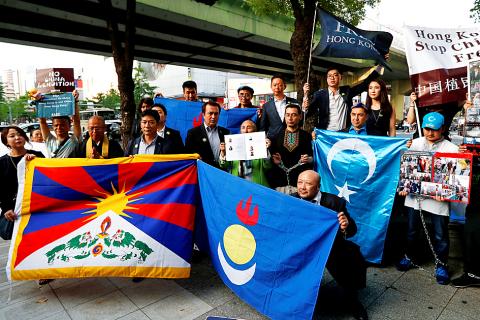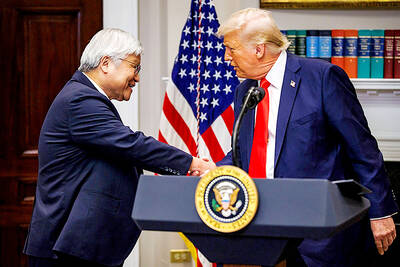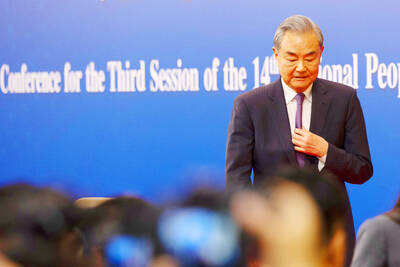US President Donald Trump yesterday struck a conciliatory tone with fellow world leaders at one of the most high-stakes G20 meetings in years, despite deep divisions on trade and climate change.
Japanese Prime Minister Shinzo Abe appealed for unity, with a long-running trade dispute between China and the US threatening to overshadow the event in Osaka.
The appeal seemed to have chimed with arguably the club’s most volatile member, as Trump dialed down his rhetoric against traditional US allies.

Photo: Reuters
Fresh from describing Germany as a “delinquent” for not paying enough into the NATO budget, he was effusive when meeting German Chancellor Angela Merkel.
“She’s a fantastic person, a fantastic woman and I’m glad to have her as a friend,” he said.
Merkel appeared well during the talks, a day after a second public shaking attack raised fears about her health. German officials have said that she is not ill.
Trump also hailed Abe for sending “many automobile companies” to the US, apparently heartened by a document Abe gave him showing investment in the US.
World leaders mingled and greeted each other during the family photograph, with French President Emmanuel Macron and European Commission President Jean-Claude Juncker whispering extensively into Trump’s ear.
Trump entered with Russian President Vladimir Putin, chatting amicably, and Putin patted his US counterpart gently on the back as they parted ways.
The pair met later for the first face-to-face talks since Helsinki in July last year with Trump hailing a “very, very good relationship.”
The meeting came after Putin in an interview with the Financial Times said that the “liberal idea has become obsolete,” a view that met with strong pushback from European Council President Donald Tusk.
“What I find really obsolete are authoritarianism, personality cults, the rule of oligarchs,” Tusk said.
Putin later received a broadside from British Prime Minister Theresa May, who said that normal relations would not be restored until Moscow ends its “irresponsible and destabilizing” activity.
It was their first formal face-to-face since the poisoning in the English city of Salisbury of former spy Sergei Skripal last year that plunged ties into a deep freeze.
Despite warm first encounters, the meeting could be one of the most explosive in years, with clashes possible over trade, Iran and climate change.
“We are seeing rising tension over trade and geopolitics, which are downside risks,” a Japanese official said on the sidelines.
The most eagerly anticipated event is to be today, when Trump and Chinese President Xi Jinping (習近平) hold their first face-to-face talks since the last G20, to thrash out a truce in their trade dispute.
Experts believe there is little chance of a full deal immediately, saying that the best hope is for a truce that would avoid Washington imposing new tariffs and ramping up the conflict.
However, even a truce is not guaranteed, with the Wall Street Journal on Thursday reporting that Beijing would not agree to any deal unless Washington lifts its ban on Huawei Technologies Co (華為).
Trump yesterday made a push to discuss US concerns about the Chinese telecom.
“We actually sell Huawei many of its parts,” Trump said at his meeting with Indian Prime Minister Narendra Modi. “So we’re going to be discussing that and also how India fits in, and we’ll be discussing Huawei.”
Also looming over the talks were tensions in the Middle East, but here Trump also seemed to step back, saying there was “no rush” to solve the crisis that has sparked fears of a military conflict.
Additional reporting by Reuters

CRITICAL MOVE: TSMC’s plan to invest another US$100 billion in US chipmaking would boost Taiwan’s competitive edge in the global market, the premier said The government would ensure that the most advanced chipmaking technology stays in Taiwan while assisting Taiwan Semiconductor Manufacturing Co (TSMC, 台積電) in investing overseas, the Presidential Office said yesterday. The statement follows a joint announcement by the world’s largest contract chipmaker and US President Donald Trump on Monday that TSMC would invest an additional US$100 billion over the next four years to expand its semiconductor manufacturing operations in the US, which would include construction of three new chip fabrication plants, two advanced packaging facilities, and a research and development center. The government knew about the deal in advance and would assist, Presidential

‘DANGEROUS GAME’: Legislative Yuan budget cuts have already become a point of discussion for Democrats and Republicans in Washington, Elbridge Colby said Taiwan’s fall to China “would be a disaster for American interests” and Taipei must raise defense spending to deter Beijing, US President Donald Trump’s pick to lead Pentagon policy, Elbridge Colby, said on Tuesday during his US Senate confirmation hearing. The nominee for US undersecretary of defense for policy told the Armed Services Committee that Washington needs to motivate Taiwan to avoid a conflict with China and that he is “profoundly disturbed” about its perceived reluctance to raise defense spending closer to 10 percent of GDP. Colby, a China hawk who also served in the Pentagon in Trump’s first team,

SEPARATE: The MAC rebutted Beijing’s claim that Taiwan is China’s province, asserting that UN Resolution 2758 neither mentions Taiwan nor grants the PRC authority over it The “status quo” of democratic Taiwan and autocratic China not belonging to each other has long been recognized by the international community, the Mainland Affairs Council (MAC) said yesterday in its rebuttal of Beijing’s claim that Taiwan can only be represented in the UN as “Taiwan, Province of China.” Chinese Minister of Foreign Affairs Wang Yi (王毅) yesterday at a news conference of the third session at the 14th National People’s Congress said that Taiwan can only be referred to as “Taiwan, Province of China” at the UN. Taiwan is an inseparable part of Chinese territory, which is not only history but

INVESTMENT WATCH: The US activity would not affect the firm’s investment in Taiwan, where 11 production lines would likely be completed this year, C.C. Wei said Investments by Taiwan Semiconductor Manufacturing Co (TSMC, 台積電) in the US should not be a cause for concern, but rather seen as the moment that the company and Taiwan stepped into the global spotlight, President William Lai (賴清德) told a news conference at the Presidential Office in Taipei yesterday alongside TSMC chairman and chief executive officer C.C. Wei (魏哲家). Wei and US President Donald Trump in Washington on Monday announced plans to invest US$100 billion in the US to build three advanced foundries, two packaging plants, and a research and development center, after Trump threatened to slap tariffs on chips made